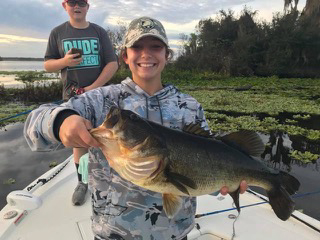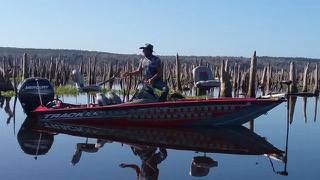
Jumbo bass like this one are an everyday catch on Rodman Reservoir, an impoundment of Florida's Ocklawaha River northeast of Ocala. Photo courtesy Rodmanreservoir.org with permission).
|
Free-flowing rivers are nearly always a good thing, but in some cases, impounded rivers are even better things.
To be sure, many western rivers have been ruined for fish production by dams—salmon and steelhead that must run into free-flowing cold water rivers to spawn suffer enormously, with some runs of these highly-valued fish almost exterminated by multiple dams on big rivers like the Columbia.
But in Florida, there’s a dam that appears to do at least as much good as harm.
The Rodman Reservoir, aka George Kirkpatrick Dam northeast of Ocala in Ocala National Forest, backs up a 9500 acre reservoir on the Ocklawaha River that produces some of Florida’s best trophy bass fishing year after year. It just recently played in John Crews Bassmaster Elite win on the St. Johns River—Crews locked into the lake for a major part of his winning catches.
I fished the lake with Senator Kirkpatrick many years ago, and swimming live shiners around the weedmats, we put two 8 pound largemouths in the boat, along with over a dozen fish in the 4 to 5 pound class. It was nothing unusual for the lake—it’s stiff with giant bass.
And, the ability of the dam to raise and lower water levels helps keep it that way. When the lake becomes too overgrown with weeds, production drops—and Florida’s Fish and Wildlife agency can drop the water level to allow the bottom to dry out for a few months. When the lake refills, there’s an enormous rebound effect.
The process is repeated every three to four years, with the water level decreased by approximately 10 feet for several months. This gets rid of all the excess weeds, and also concentrates all the bass in the remaining river channel, where they stuff themselves with the clustered prey. The lake then refills and the fish spread out into essential “new” water, where they get another big growth spurt.
The result is an ever-renewing bass factory that continuously turns out fish in the 8 to 10 pound class at a rate higher than almost any other lake in the state.
Anglers from all over the nation come to Florida specifically to catch a lifetime trophy at Rodman.

Rodman is loaded with flooded timber that makes excellent bass habitat, and the water level is managed to assure continuing fish production. Photo courtesy of rodmanreservoir.org with permission.
|
The lake has been a tremendous boon to one of Florida’s few remaining backwoods areas. And the river swamp alongside it still provides excellent habitat for countless water birds, osprey and bald eagles, deer and turkey, gators and even growing populations of black bears.
While eliminating the dam would eventually add those 9500 acres of habitat back to the river-swamp, it would greatly reduce the fishery potential, since riverine habitat does not present the same opportunities for trophy bass growth nor for panfish fisheries as a water-level-managed lake.
It would also wipe out the livelihoods of the hundreds of area residents who depend on the lake for income from guiding, bait sales, fish camp lodging, boat sales and lots more. (If you’d like to sample the fishing yourself, Captain Sean Rush is one of the top guides on the lake: www.floridatrophybass.com.)
RodmanReservoir.org says that the lake contributes over $6 million per year to the economies of Putnam and Marion counties, and is the 13th most visited public land in the state’s 129 total.
Since nearly all bass are released unharmed, the fish just keep getting bigger.
Right now is prime time for a lunker there, incidentally—from December through early March the bite for the biggest fish of the year is on.
In any case, well-meaning conservationists continue to push for elimination of the dam, which would eliminate the lake completely and return the river to its natural course.
While the river swamp would regrow over a few decades, the world-class bass fishery would be gone forever.
To be sure, there are some advantages to the river versus the lake. More river swamp would mean more terrestrial wildlife—more deer and turkeys and small game and bird life. The free flowing river would no doubt become a float trip destination for kayakers and canoeists, as well.
But there would no doubt be fewer alligators and ospreys and bald eagles, as well as fewer wading birds, which currently thrive due to the repeated drawdowns.
Overall, the greatest benefit to the greatest number seems to be leaving Rodman Reservoir as it is to continue to produce some of the nation’s best fishing for new generations of anglers, and continuing to support all the fishing-related businesses that have grown up around the lake.
- Frank Sargeant
Frankmako1@gmail.com